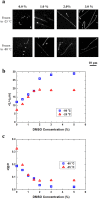A single-molecule assessment of the protective effect of DMSO against DNA double-strand breaks induced by photo-and γ-ray-irradiation, and freezing
- PMID: 28819291
- PMCID: PMC5561226
- DOI: 10.1038/s41598-017-08894-y
A single-molecule assessment of the protective effect of DMSO against DNA double-strand breaks induced by photo-and γ-ray-irradiation, and freezing
Abstract
Dimethyl sulfoxide (DMSO) is widely used as a cryoprotectant for organs, tissues, and cell suspension in storage. In addition, DMSO is known to be a useful free radical scavenger and a radio-protectant. To date, many in vitro assays using cultured cells have been performed for analysing the protective effect of DMSO against genomic DNA damage; however, currently it has been rather difficult to detect DNA double strand breaks (DSBs) in a quantitative manner. In the present study, we aimed to observe the extent of DNA damage by use of single molecular observation with a fluorescence microscope to evaluate DSBs induced by photo- and γ-ray-irradiation, or freeze/thawing in variable concentrations of DMSO. As a result, we found that 2% DMSO conferred the maximum protective effect against all of the injury sources tested, and these effects were maintained at higher concentrations. Further, DMSO showed a significantly higher protective effect against freezing-induced damage than against photo- and γ-ray-irradiation-induced damage. Our study provides significant data for the optimization of DNA cryopreservation with DMSO, as well as for the usage of DNA as the protective agent against the injuries caused by active oxygen and radiations.
Conflict of interest statement
The authors declare that they have no competing interests.
Figures





References
-
- Runge R, Oehme L, Kotzerke J, Freudenberg R. The effect of dimethyl sulfoxide on the induction of DNA strand breaks in plasmid DNA and colony formation of PC Cl3 mammalian cells by alpha-, beta-, and Auger electron emitters 223Ra, 188Re, and 99 mTc. EJNMMI Res. 2016;6:1–10. doi: 10.1186/s13550-016-0203-x. - DOI - PMC - PubMed
Publication types
MeSH terms
Substances
LinkOut - more resources
Full Text Sources
Other Literature Sources
Research Materials

